Northridge is a neighborhood in the San Fernando Valley region of the City of Los Angeles. The community is home to California State University, Northridge, and the Northridge Fashion Center.

Pine Mountain Club is an unincorporated area and census-designated place in southwestern Kern County, California. As of the 2010 census it had a population of 2,315.
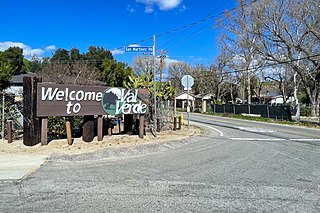
Val Verde is an unincorporated community in the southeastern Topatopa Mountains foothills, and in northwestern Los Angeles County, California. The unincorporated community of Valencia is southeast, and the city of Santa Clarita is east of the community. Its population was 2,468 at the 2010 census, up from 1,472 at the 2000 census. For statistical purposes the Census Bureau has defined Val Verde as a census-designated place (CDP).
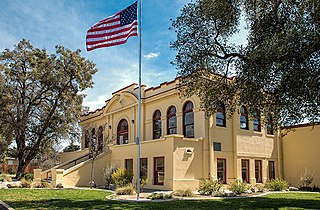
Beaumont is a city in Riverside County, California, United States, located at the summit of the San Gorgonio Pass, between the San Bernardino Mountains and Mount San Gorgonio to the north, and the San Jacinto Mountains and San Jacinto Peak to the south.
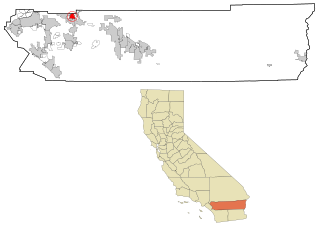
Cherry Valley is a census-designated place (CDP) in Riverside County, California, United States. The population was 6,362 at the 2010 census, up from 5,891 at the 2000 census. It is situated at the most northwestern point of the San Gorgonio Pass.

Apple Valley is an incorporated town in the Victor Valley of San Bernardino County, in the U.S. state of California. Its population was 75,791 as of the 2020 United States Census. The town is east of and adjoining to the neighboring cities of Victorville and Hesperia, 35 miles (56 km) south of Barstow, and 49 miles (79 km) north of San Bernardino through the Cajon Pass. It was incorporated on November 14, 1988, and is one of the 22 incorporated municipalities in California that use "town" in their names instead of "city".
A guest ranch, also known as a dude ranch, is a type of ranch oriented towards visitors or tourism. It is considered a form of agritourism.

Herb Jeffries was an American actor of film and television and popular music and jazz singer-songwriter, known for his baritone voice.
Tejon Ranch Company, based in Lebec, California, is one of the largest private landowners in California. The company was incorporated in 1936 to organize the ownership of a large tract of land that was consolidated from four Mexican land grants acquired in the 1850s and 1860s by ranch founder Edward Fitzgerald Beale.
Manzanar was a town in Inyo County, California, founded by water engineer and land developer George Chaffey. Most notably, Manzanar is known for its role in the internment of Japanese Americans during World War II.

Thomas R. Yarborough was an American civic leader and politician. In 1948, he became the first African American elected to a California city council. In 1966, Yarborough became the first African American mayor of Lake Elsinore, California, and one of three African Americans to be elected mayor that year in California.

Palm Springs is a desert resort city in Riverside County, California, United States, within the Colorado Desert's Coachella Valley. The city covers approximately 94 square miles (240 km2), making it the largest city in Riverside County by land area. With multiple plots in checkerboard pattern, more than 10% of the city is part of the Agua Caliente Band of Cahuilla Indians reservation land and is the administrative capital of the most populated reservation in California.

Harlem on the Prairie (1937) is American race movie, billed as the first "all-colored" Western musical. The movie reminded audiences that there were black cowboys and corrected a popular Hollywood image of an all-white Old West.
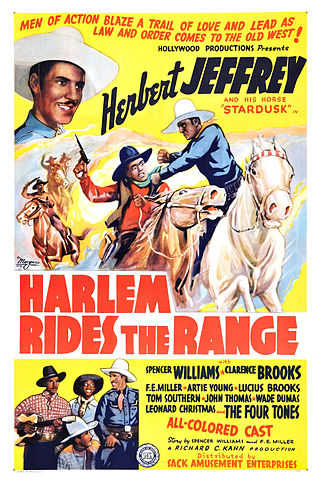
Harlem Rides the Range is a 1939 American Western race film directed by Richard C. Kahn. It followed the groundbreaking 1937 Western musical film Harlem on the Prairie.
Bell Mountain is an unincorporated community in the Victor Valley region of the Mojave Desert, within San Bernardino County, southern California.
B Bar H Ranch, California is an unincorporated area with cultural and historical features and is a residential community in Riverside County, California. B Bar H Ranch is located between Palm Springs and Desert Hot Springs in the Seven Palms Valley. California Home Town Locator states the B Bar H Ranch Latitude is 33.9102927 and Longitude is -116.4819566. The GNIS entry date is January 19, 1981. B Bar H Ranch sits at an elevation of 784 feet (239 m). B Bar H Ranch is approximately eight miles north of Palm Springs, California and approximately six miles south of Desert Hot Springs, California. B Bar H Ranch's approximate 240 acres are bordered by 18th Avenue to the north, Mountain View Road to the east, 20th Avenue to the south, and Bubbling Wells Road to the west. B Bar H Ranch consisted of approximately 899 residents as of the 2010 US Census.

Dorothy Vena Johnson was an American poet and educator based in Los Angeles, California. In 1939, she was co-founder of the League of Allied Arts, an African-American women's arts organization.
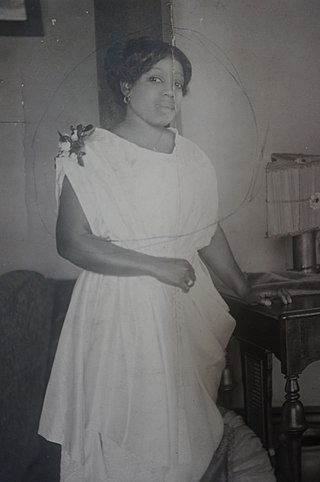
Lela Murray was a prominent black businesswoman, community leader, and advocate for civil rights in Los Angeles during the first half of the 20th century. She co-founded Murray's Ranch, billed by the press as "the only Negro dude ranch in the world," in Bell Mountain, California, providing a place of recreation and leisure to people of color during a period of racial segregation and anti-black sentiment in the United States.

During the decades of segregation in the United States, African Americans established various resorts. The resorts were self-contained commercial establishments. Varying resort accommodations included rooms for rent, meals and fine food, cocktail bars, dancing, sporting facilities, and beaches. Also in some cases entire communities were known as resort areas for African Americans. The Negro Motorist Green Book helped guide African Americans to accommodating and safe places, including Idlewild, Michigan, which was among the most well known.













